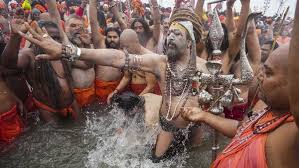The History of Maha Kumbh Mela: A Journey Through Time and Tradition
The Maha Kumbh Mela, one of the largest and most significant religious gatherings in the world, is a spectacular confluence of spirituality, tradition, and culture. Held every twelve years at four sacred locations in India—Prayagraj (formerly Allahabad), Haridwar, Ujjain, and Nashik—the event is a deeply rooted celebration of faith, with millions of devotees coming together to bathe in the holy rivers to cleanse themselves of sins and attain spiritual liberation. This extraordinary festival has evolved over centuries, shaped by a rich history and vibrant traditions.
Let’s embark on a journey to explore the fascinating history of the Maha Kumbh Mela and its significance in Indian culture and spirituality.

The Origins of Maha Kumbh Mela
The origins of the Kumbh Mela can be traced back to ancient Hindu mythology. The term “Kumbh” means a “pot” and “Mela” means a “gathering.” According to the mythological story, the gods and demons once churned the ocean (Samudra Manthan) to obtain the nectar of immortality, known as “amrit.” During this churning, a few drops of the divine nectar fell at four locations on Earth: Prayagraj, Haridwar, Ujjain, and Nashik. These places are now considered sacred, and the Kumbh Mela is held at these locations to commemorate this divine event.

The Kumbh Mela finds mention in several ancient Hindu scriptures, including the Vedas, Puranas, and epics like the Mahabharata and Ramayana. It is believed that participating in the Kumbh Mela and taking a holy dip in the waters of the sacred rivers cleanses the soul and frees individuals from the cycle of life and death (moksha).
The Spiritual Significance of the Kumbh Mela
The Maha Kumbh Mela is more than just a religious event—it is an expression of deep spiritual beliefs and traditions. Devotees come to these holy riverbanks with the firm belief that taking a ritualistic bath in the sacred waters purifies them from past sins. The spiritual atmosphere at the event is intensified by the presence of saints, yogis, and ascetics who perform their own ceremonies, prayers, and meditations.
One of the most important aspects of the Kumbh Mela is the grand procession of the “Naga Sadhus” (naked ascetics) and other religious groups. These devotees, often dressed in traditional attire, symbolize the ascetic lifestyle and devotion. Their participation in the Kumbh Mela signifies the importance of renunciation and dedication to spiritual growth.
At the heart of the Kumbh Mela is the idea of collective spiritual awakening. The act of bathing together in the sacred rivers symbolizes the purification of the body and soul, while the communal atmosphere fosters unity and brotherhood among people from all walks of life.
The Evolution of Maha Kumbh Mela Over Time
The tradition of the Kumbh Mela has continued for thousands of years, and its significance has only grown stronger over time. While the ritual of bathing in sacred rivers has remained the same, the scale and grandeur of the event have transformed with the passage of time. What began as a local gathering has now evolved into a global phenomenon, attracting millions of pilgrims and tourists from all corners of the world.
Historically, the Kumbh Mela was held at fixed intervals, based on astronomical and astrological alignments. The most significant gathering, the “Maha Kumbh,” occurs once every 12 years, when the planetary positions are considered especially favorable. The last Maha Kumbh Mela in Prayagraj in 2013 drew an estimated 120 million people, making it one of the largest human gatherings in history.
With modern technology, the Kumbh Mela has been adapted to meet the needs of millions of attendees. State-of-the-art infrastructure, including temporary camps, medical facilities, sanitation services, and transportation systems, ensures the safety and comfort of the participants. Furthermore, digital media and live broadcasting of events have made it possible for people from around the world to witness the religious festivities remotely.
The Cultural and Social Impact of Maha Kumbh Mela
Beyond its spiritual significance, the Kumbh Mela is an important social and cultural event. It serves as a vibrant platform for cultural exchange, where people from diverse backgrounds come together to celebrate the rich tapestry of Indian traditions. Pilgrims participate in religious discourses, devotional singing (kirtans), and cultural performances, fostering a sense of unity among India’s vast diversity.
The Kumbh Mela also holds a great importance in terms of social interaction. People from rural and urban backgrounds, of various caste, creed, and communities, share space and resources, promoting social harmony. It is a living example of India’s pluralistic society, where diversity is celebrated and mutual respect is upheld.
The Modern-Day Maha Kumbh Mela
Today, the Maha Kumbh Mela has become not just a religious occasion, but also a significant cultural event. Its significance extends beyond the spiritual realm, drawing attention to India’s rich heritage, history, and values. In an era where globalization has brought the world closer together, the Kumbh Mela continues to serve as a reminder of the importance of spiritual connection, community, and the preservation of ancient traditions.
Conclusion
The Maha Kumbh Mela is more than just an event—it’s a manifestation of India’s rich spiritual heritage, where time-honored traditions converge with the ever-evolving needs of the modern world. The legacy of the Kumbh Mela, rooted in divine mythology and shaped by centuries of faith, continues to be a beacon of unity, purity, and spiritual transcendence. It is a reminder to all of us that, no matter how much time passes, the essence of faith, tradition, and community remains timeless.
other news: Maha Kumbh Mela 2025: Untold Stories Personal Accounts and Experiences महा कुम्भ मेला 2025: cultural heritage और स्थानीय शिल्प की खोज






